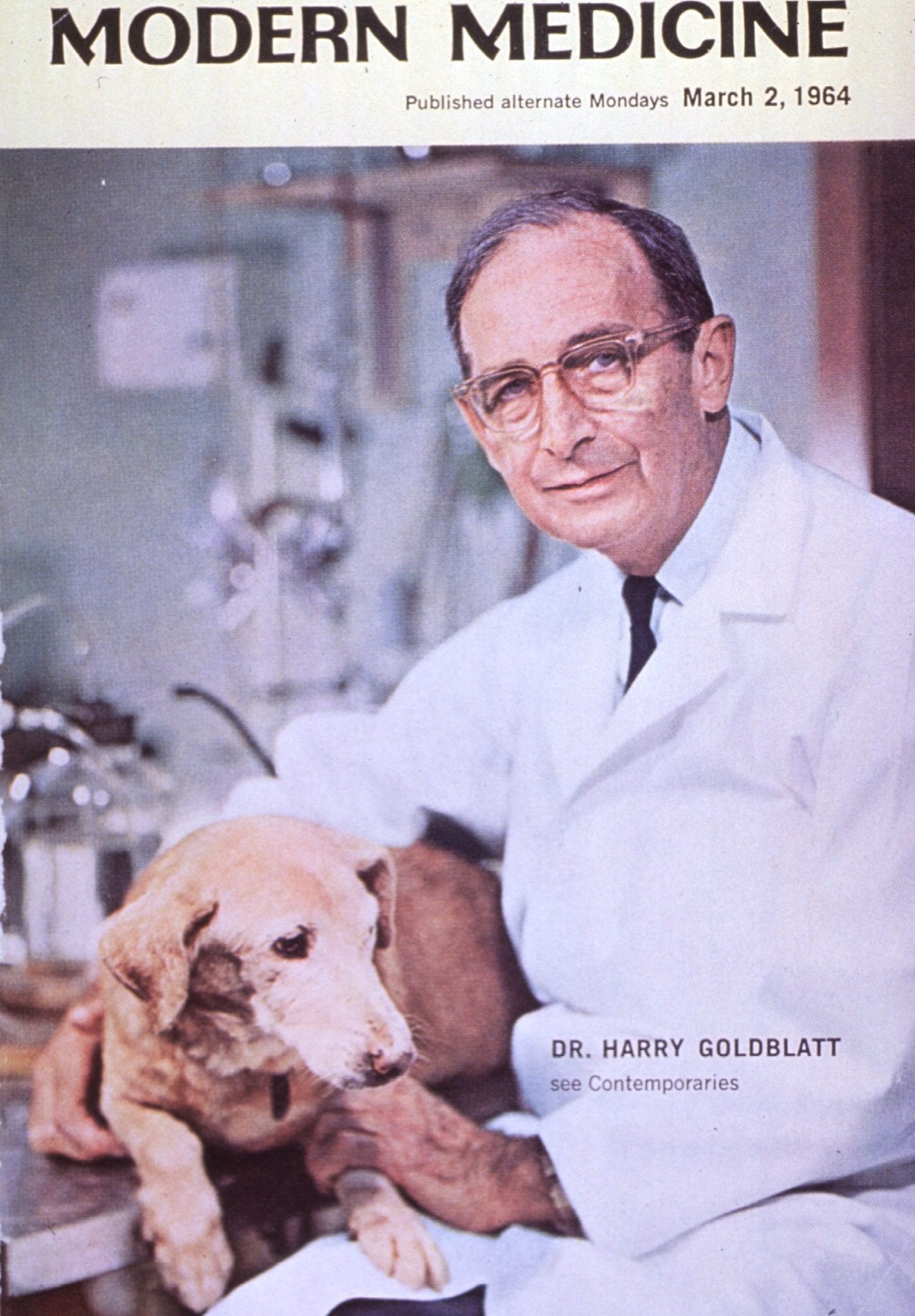 |
| Dr. Harry Goldblatt. 1964. Via the National Library of Medicine. |
In 1928 Dr. Harry Goldblatt applied silver clamps experimentally to the renal arteries of dogs and observed a significant and sustained rise in blood pressure. His main interest as a researcher was to find a cause for hypertension, a disease for which effective treatment was not available at the time. There had been a long-standing suspicion that the kidney had something to do with hypertension, and as early as 1825 Richard Bright had described cardiac enlargement (a surrogate for hypertension) in patients dying from renal disease. Underscoring this uncertainty were the writings of the British physician Peter Mere Latham, who in 1865 noted that “what exact relation diseases of the kidney bears to hypertrophy of the heart, we do not know even yet. But the two are too often coincident in the same subjects for them not to bear some, and that a very important, relation to each other.”1
More direct experimental evidence had come from Sweden, where, in 1898, Robert Tigerstedt and Per Bergman had caused a dramatic rise in the blood pressure of rabbits by injecting them with an extract of kidney tissue. They named this hypothetical substance renin. Experiments like those of Harry Goldblatt would prove that the fundamental cause of hypertension resided in the kidney. Several investigators followed up on this clue, notably John Lausch, who induced transient but not sustained hypertension some two years before Goldblatt but published in German and received little notice.2
Harry Goldblatt was born in 1891 in Iowa and studied at McGill University and at the Lister Institute in London. In 1924 he became professor of pathology at Western Reserve University. While carrying out autopsies, he had often noted vascular narrowing in the renal arteries or in its branches in patients with hypertension. He accordingly devised his memorable experiment in which he applied an adjustable clamp that allowed him to occlude or narrow the renal arteries in dogs and induce sustained hypertension.3 His work attracted immediate attention. Sometime later renin was isolated and shown not to cause hypertension by itself but function as an enzyme that caused the release of angiotensin. Much has been learned since then about the renal-angiotensin system, and indeed angiotensin-converting-enzyme inhibitors and angiotensin-receptor blockers are now widely used to treat elevated high blood pressure.
After a stint as director of the Institute for Medical Research at Cedars of Lebanon Hospital in Los Angeles, Goldblatt returned to Cleveland in 1953 to work at Mount Sinai Hospital. He studied not only the kidney but also nutrition, cirrhosis of the liver, vitamins, and rickets. He retired in 1976 and died the next year. He received many honors during life and the “Goldblatt kidney” became recognized as a possible cause of hypertension. But when measurements of blood renin levels in hypertensives became clinically available they were found to most often be low, and it became clear that hypertension in man was mostly caused not by excess renin production but was somehow related to expansion of the blood volume, often by excessive salt intake.
Goldblatt’s work nevertheless served to focus attention on the kidney. As a result, until about 1960 many patients underwent nephrectomies but few were cured.4 The introduction of renal angiography later shifted the focus to identifying and curing hypertension by restoring the blood supply to the kidneys by surgery or angioplasty. However, by 2014 the negative results of several national cooperative studies substantially lowered enthusiasm for renal vascular repair, especially with the realization that atherosclerosis of the renal artery was accompanied by even more severe vascular disease of the heart and brain. Angioplasty of the renal arteries is now largely limited to cases of intractable hypertension, progressive loss of renal function, and the phenomenon of sudden “flash” pulmonary edema. Thus, the riddle of essential hypertension not been completely solved, but the work of Harry Goldblatt remains an important signpost in a long journey yet to be completed.
References
- Bean W. Aphorisms from Latham, Iowa City, Prairie Press. 1962. Page 81.
- Glodny B and Glodny DE. John Loesch, Discoverer of renovascular hypertension and Harry Goldblatt: two great pioneers in circulation research. Ann. Int. Med, 2006; 144:286.
- Van Epps HL. Harry Goldblatt and the discovery of renin. J Exp Med. 2005; 201: 1351.
- Berman, LB. Harry Goldblatt 1891- 1977. JAMA 1977; 238:1848.
GEORGE DUNEA, MD, Editor-in-Chief
Fall 2020 | Sections | Nephrology & Hypertension

Leave a Reply